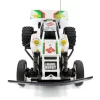Note: By popular demand, Nikko is being added; however, this topic is still being researched, and information should not be relied upon until this message disappears. If you see a mistake, please comment below or contact me.
Note: Article includes both 1986 and 1987 Turbo Panther versions.
The Nikko Turbo Panther was a radio controlled car produced by Nikko R/C Systems (Japan), released in Japan and eventually worldwide in 1986, with a slight update in 1987. One of the first powerful, dynamic, and low cost toy R/Cs to ever hit the market, alongside the 1986 Tyco Turbo Hopper.

The R/C Car Craze of the Mid 1980s
In 1976 Tamiya (Japan) began manufacturing radio controlled cars, after initially making wooden models of airplanes and ships, then later switching to plastic models of military equipment, airplanes, and sports cars.
Several years later in 1983 they would release the Tamiya Frog, their most popular model to date, kick starting the radio controlled car craze of the 80s, and elevating the hobby from mere toy into a competitive sport.
By 1985 Nikko would release their 1/10 scale Nikko F-10 Bison Frame Buggy, a ready to run car that seems to have been inspired by the Tamiya Frog, Hornet, and Grasshopper, but in a ready-to-run form it would have hit the market like a thunder bolt.



For some, this would have been their first real taste of high performance R/C, though like their Tamiya counterparts it was still relatively expensive. Actual hobby grade cars were even more inaccessible in price, and also required the time, skill, and patience to build.
Toy grade cars, mostly just models of real life vehicles, were slow, without suspension or any real 'dynamics', and were practically models with a small electric motor and vague steering leading to a cheap, heavy, and uninspiring experience.
It would take some entrepreneurship and market competition from the numerous Japanese model and toy companies such as Yonezawa, Taiyo, Tomy, and Shinsei, together with Nikko, to break into a larger consumer audience with the release of smaller, ready-to-run, 1/16 scale radio controlled cars that would boast many of the features of the hobby grade cars, at a fraction of the price.
With a design inspired by its popular F-10 Bison, Nikko would in 1986 release the Nikko Turbo Panther, their most popular breakout model that sold incredibly well with everyday folk both in Japan, and more importantly in the international market.

Japanese Packaging
So much was the similarity to the Nikko F-10 Bison, on the Japanese box it was additionally labelled Bison Junior.
Yet who came first? The Taiyo Jet Hopper (sold as the Tyco Turbo Hopper in the USA) or the Nikko Turbo Panther?
I don't know myself, but their release the same year with relatively similar price and specifications would create a street rivalry between kid neighbors not seen since Ford vs Ferrari (or Ford vs Holden if you're Australian like me!).
As a Metro/Tyco owner, if you had a Nikko then you were the enemy! Even worse than that kid with the Black Turbo Hopper, since everyone knows that Red Turbo Hoppers are the fastest!
Features and Performance
In terms of technical specifications, the Nikko Frame Buggy was impressive.
- 1/16 Scale Full Function R/C car
- Speeds of up to 20 km/h
- 8 x AA Batteries (or 9.6V with rechargeable batteries)
- Mabuchi RC280 Motor
- Front and Rear Suspension (Shock Absorbers)
- Rear Off Road Tires with Differential
- Front Smooth Tires (1986), Front Spiked Tires (1987)
- Wide bumper with curve around edges (1986), Slim Traditional Bumper (1987)
- 2 Speed Gearbox (High, Low)
- Available in Red (27.145Mhz) and White (49.860Mhz)

It's interesting that this and many other R/C cars at the time (including the Jet Hopper) were Made in Singapore for the global market, typically with the original home release being Made in Japan once the technique had been perfected, as is the tradition with Japanese companies even today.


1985, 1986 and 1987 versions
There is some evidence that the Nikko Turbo Panther first released in 1985, not 1986 as described here.
See adjacent image from a 1985 Nikko Catalog from France, however that machine looks quite different to the car that was eventually released, so it may have been a prototype, or simply production began in 1985 but wasn't on the market officially until the 1986 toy season.

Versions and improvements over time (1986 vs 1987)
As with most products, the Turbo Panther evolved over time with minor changes while still being sold as the same product, same model number.
In 1987 there were minor changes to the design with upgrades in 3 key areas, though there have been reports of inconsistencies (older parts on 'newer' cars, and vice versa) which could be due to 3rd party repairs, or the factories simply used up all the parts they had before switching to new ones.
- Front Tires
Released in 1986 with 'Smooth' thin front tires, these were later replaced with "Spiked" tires similar to the rears. This may be considered a MK2 upgrade by some, generally occurring from the 1987 model year, though there is some inconsistencies. - Front Bumper
Released in 1986 with a very wide bumper that curved around the sides/corners a little, this was eventually updated in 1987 to a smaller, less wide and more typical looking bumper. - Front Suspension Arms
The 1987 version changed the design of the front suspension arms slightly, to make them more solid, thicker, and generally less prone to breaking in a crash.


While I often use designations like MK1 and MK2 with Tyco and Taiyo products, my research so far has shown that the Panther may have grown more organically. While generally the 1986 versions will have smooth front tires and a wrap around bumper, and the 1987 version will have smaller bumper and spiked tires, this isn't always the case, as you can see from example photos provided.

Is the Turbo Panther better than the Turbo Hopper / Jet Hopper?
No.
Okay okay, yes, in many ways it is, and other ways it isn't.
Top Speed: Jet Hopper / Turbo Hopper wins
The advertised top speed of the Turbo Panther was 12.5mph (20km/h) and 14.3mph (23km/h) for the Turbo Hopper. Later variants of the Hopper increased this to almost 17mph (27km/h).
Acceleration: Turbo Panther wins
Apparently the Turbo Panther accelerates faster, though I have not independently verified this myself. It would make sense though, as we know the Turbo Hopper had a higher top speed, so the Panther was likely geared lower so accelerated faster but maxed out quicker.
Off Road: Jet Hopper / Turbo Hopper wins
With no differential, the Hopper is better in off-road situations as it will transmit power to both rear wheels in all situations. With a differential, the Panther will transmit power to the wheel with the least resistance, meaning that wheel could be off the ground while the other wheel is stuck in the mud and not turning.
On Road: Turbo Panther wins.
Faster acceleration and a differential is a clear benefit while driving on road.
Overall: On a technical basis, even as a Tyco/Taiyo fanboy myself, I have to admit that the Nikko Panther, and Nikko products generally are very impressive. Which one is better though? Whichever you had as a kid, obviously!
Passive Steering
Like early versions of the Taiyo Jet Hopper (but not the Tyco Turbo Hopper), the earlier variants of the Turbo Panther had what I call 'passive steering', where the steering servo only works when you're moving either forward or backward. This isn't as much of an issue when racing around outside, however it can be annoying when just playing indoors, especially in a smaller area since you can't turn as soon as you move, you need to get moving first, then turn. This was later resolved in both cars, into what I call 'active steering' where you can turn the wheels even if the car is stopped.
Availability and Collectability
Such an iconic car as the Nikko Turbo Panther is absolutely collectable, and as the first R/C car for many, it's a bounty of nostalgia, a heart warming, feel good, "oh those were simpler times!" object of toy store beauty that only 9 year olds from the 1980s (and 40 year olds from the 2020s) can truly appreciate!
As for whether or not you'll ever find one in a decent condition at a price that doesn't make your wallet run screaming, well, yeah, you're going to need to be patient and determined. Or maybe just really good at telling the wife you found it on the roadside, someone was just throwing it away! hah! imagine that!









































